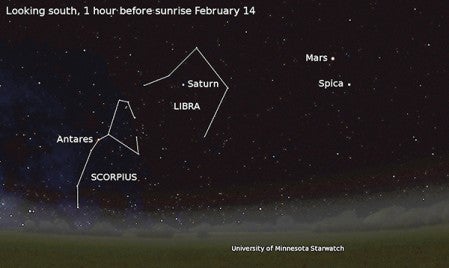Starwatch: February
Published 8:01 am Sunday, February 2, 2014
A University of Minnesota feature by Deane Morrison
This is a new feature from the University of Minnesota that will run in the Austin Daily Herald’s Spotlight section once a month, featuring guidance on where to turn our eyes to gaze upon the stars.

The knot of bright winter constellations reaches its highest point in the south during the mid-evening hours of February. Most recognizable is Orion, with his glowing sword hanging below the three stars of his belt.
Orion’s two brightest stars are among the most famous: Betelgeuse and Rigel. Both are gigantic stars classified as supergiants. Ruddy Betelgeuse and blue-white Rigel are believed to be less than 10 million years old—much younger than the sun’s 4.5 billion years—and are burning their nuclear fuel much faster than the sun.
Light from Rigel illuminates the Witch Head Nebula, a neighboring dust cloud that’s eerily reminiscent of a human profile. Rigel shines at Orion’s southwestern foot, Betelgeuse at his opposite shoulder. Northeast of Orion, Jupiter is still a big, bright ornament in Gemini. And below Orion, Sirius, the brightest star in the night sky, is now at its finest.
In the last week of February, try to catch the faint, lovely zodiacal light an hour or two after sunset. It glows from sunlight reflecting off dust in the plane of the solar system, and appears as a broad band of light extending up from the western horizon along the sun’s path, dimming with distance from the sun.
In the morning sky, Mars is in the south to southwest in the hour before sunrise, above the bright star Spica, in Virgo. To the east, Saturn glows between Mars and its stellar rival: red Antares, in Scorpius, whose sinuous form rears up from the southern horizon. And east of Scorpius, Venus makes a lovely, if somewhat low, morning star.
Earth will lap Mars in the orbital race in just two months, so the Red Planet is brightening steadily. It’s also rising earlier every night, and ends the month appearing about two hours before midnight. Saturn, too, is no slouch. On the 11th it will be 90 degrees from the sun, a position that brings the planet’s shadow on the rings into sharp contrast and gives Saturn a striking 3-D appearance.
February’s full moon was known to Algonquin Indians as the full snow moon or the hunger moon, because hunting was difficult. It rises very close to perfectly full the evening of the 14th, so this moonrise will make a round and lovely accessory for Valentine’s Day.
And then there’s Groundhog Day, which has astronomical roots. One of four “cross-quarter” days falling midway between a solstice and an equinox, it was seen by the ancient Celts as a day for forecasting the start of the planting season. The belief was that a cloudy day portended rain that would soon come to soften up the earth. But clear weather meant cold and a longer wait till spring, as well as visible shadows for any creatures astir on that day.
Find U of M astronomers and links to the world of astronomy at www.astro.umn.edu.


